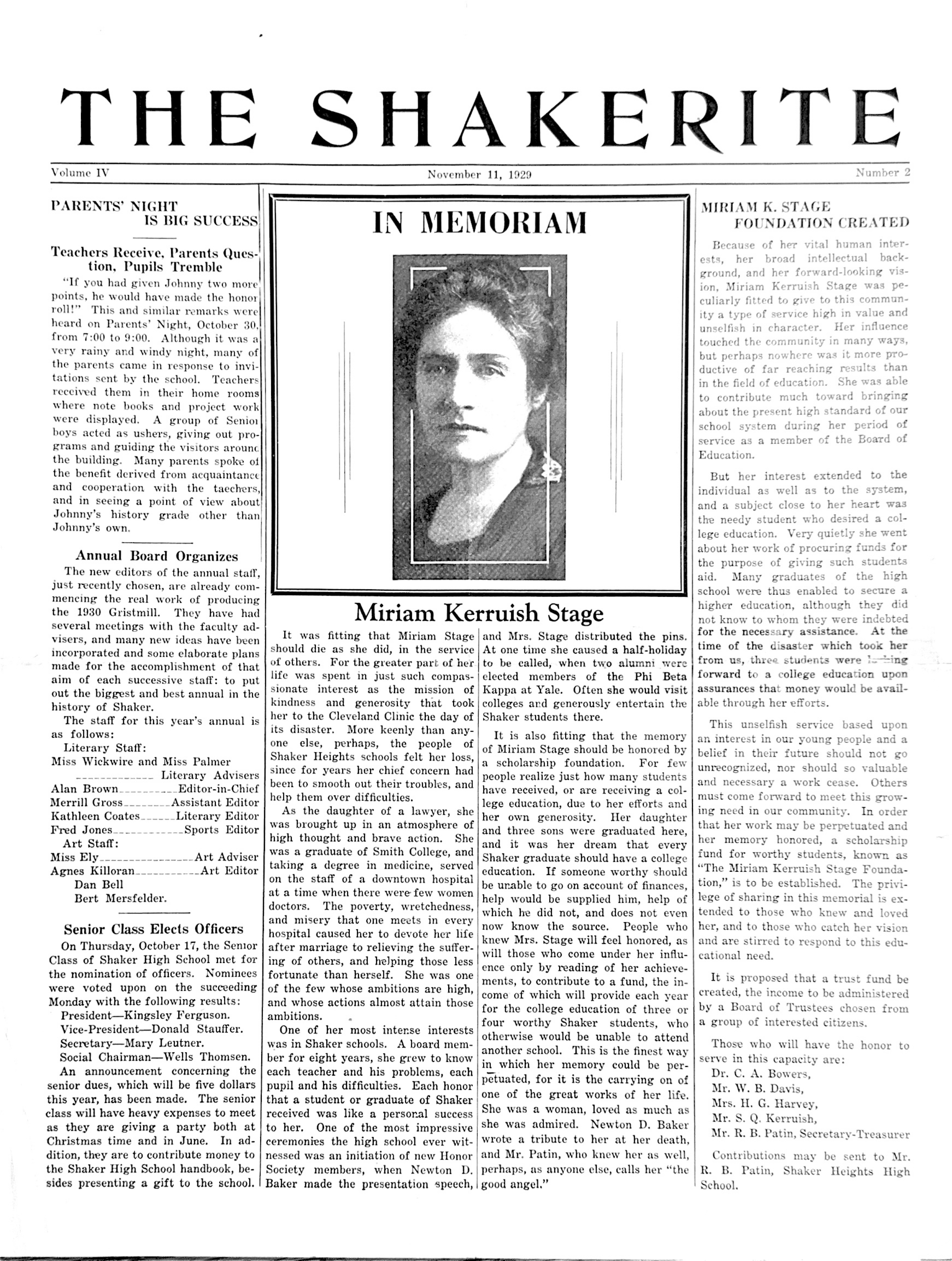Early Shakerite archive is now on line thanks to

This memorial was in the Shakerite, November 11, 1929. Dr. Kerruish’s bio is here
She was a physician, activist, a mother active in education and greatly revered in the community
www.teachingcleveland.org
Early Shakerite archive is now on line thanks to

This memorial was in the Shakerite, November 11, 1929. Dr. Kerruish’s bio is here
She was a physician, activist, a mother active in education and greatly revered in the community
Miriam Kerruish (Stage) biography The National cyclopædia of American biography 1931
Here is more on Dr. Kerruish, from this article about her husband, Charles “Billy” Stage:
…This new direction may also have been the result of a change in his personal life that occurred when Stage married Miriam Kerruish on August 27, 1903. His new bride came from a background just as extraordinary as his own. Her father, William Kerruish, was the son of emigrants from the Isle of Man and proved such an excellent student that he was admitted to the sophomore class of Western Reserve College. As would be the case for his future son-in-law, money was tight so he worked his way through school “by making beds, sawing wood and doing anything else that he could find to do.”
Kerruish brought an infectious spirit and a strong social conscience to the campus. Although American-born, he took great pride in his heritage and taught his language teachers how to speak Gaelic. He also became deeply involved in the abolitionist movement and convinced his fellow students to invite Frederick Douglass to deliver a commencement address in 1854, a choice that stirred up considerable controversy. Kerruish then finished up his education at Yale — once again teaching the Gaelic language to his instructors — and returned to Cleveland to practice law. He became the head of one of the city’s best law firms and continued to practice law until his death at age ninety-six. He also found time to marry Margaret Quayle, an emigrant from the Isle of Man, and raise a large family.
Their daughter Miriam was born in Cleveland on November 7, 1870, and shared her father’s probing intellect and social conscience. After receiving a bachelor’s of arts degree from Smith College in 1892, Miriam enrolled at Wooster Medical College and graduated in 1895. She became the first female doctor ever to practice at Cleveland City Hospital, where she specialized in obstetrics and pediatrics.
Dr. Kerruish soon became convinced that poverty was responsible for the illnesses of many of the children she was treating. She emerged as a champion of child welfare, organizing the Women’s Protective Association of Cleveland and serving on the board of trustees of the Woman’s Hospital, the Maternity Hospital Council and many other noble causes. She also became active in the woman’s suffrage movement, starting the Cuyahoga County Woman’s Suffrage Party and spearheading its activities. In the midst of all these endeavors, she also found time to give birth to and raise four children — three boys and a girl.
—————————
Once her children were old enough, Miriam Stage returned to practicing medicine. She joined the staff of the Cleveland Clinic, a medical center formed upon novel principles. It was founded by Drs. George W. Crile, Frank E. Bunts, William E. Lower, and John Phillips, three of whom had served overseas during the First World War and been impressed by the benefits of having medical specialists from a variety of disciplines working together. While serving in France, Crile marveled in his journal: “What a remarkable record Bunts, Crile and Lower have had all these years. We have been rivals in everything, yet through all the vicissitudes of personal, financial and professional relations we have been able to think and act as a unit.” (Clough, 19)
Upon returning to Cleveland they decided to open a clinic based upon a similar cross-disciplinary, cooperative approach to medicine. Central to their mission was an emphasis on research and education, as the founders believed that patient care and teaching went hand in hand. As Crile’s son later described it, the clinic was based upon a shared ideal of “an institution in which medicine and surgery could be practiced, studied and taught by a group of associated specialists. To create it, the four founders began to plan an institution that would be greater than the sum of its parts.” (Clough, 32)
Their clinic at Euclid Avenue and East 93rd Street opened its doors in 1921 and three years later a 184-bed hospital began to admit patients. At the 1921 opening, Crile articulated the vision of the founders. One of the pinnacles was ongoing education that was not departmentalized as in a university but in which doctors communicated new findings tow one another through a schedule of daily conferences and lectures. This dialogue, Crile explained, was “not only our duty to the patient of today, but no less out duty to the patient of tomorrow.” Just as important was the commitment to ensuring that, “the patient with no means and the patient with moderate means may have at a cost he can afford as complete an investigation as the patient with ample means.” (Clough, 39-41) It is easy to see why the setting was a perfect fit for Miriam Stage and she became one of the leaders of the Clinic’s Women’s Hospital.
In 1929, tragedy struck the Cleveland Clinic. On May 15, nitrocellulose x-ray films overheated, causing at least two explosions and sending lethal fumes through the building. One hundred and twenty-three people lost their lives, including Dr. Miriam Stage.
Billy Stage never remarried. While he was still in mourning, the stock market crash brought an end to the Van Sweringens’ empire. He retired in 1939 and passed away on May 17, 1946, at the Cleveland Clinic where his wife had practiced and met her untimely death. His death occurred on the seventeenth anniversary of his wife’s funeral.